
In 1884, Léon Breitling at the age of 24 founded the Breitling watch factory in Saint Imier, a production centered on the development of chronograph watches. Right from the start, Léon Breitling researched and designed a large number of modifications to known chronograph mechanisms.
In 1892, the factory will move to La Chaux de Fond and will settle in a street which will become rue Montbrillant (street which will give its name to the Breitling watch of the 1950s). The factory will then take the name of "Léon Breitling, Montbrillant Watch Manufactory". When Léon Breitling died in 1914, his son, Gaston, took over the reins of the family factory, aged just 30.

Breitling remains a watchmaking brand inseparable from the conquest of the skies, the Navitimer chronograph is, moreover, the wristwatch model that comes spontaneously to the mind of any aviation enthusiast, a look back at the life of a manufacture dedicated to the aviation and the automobile in all its forms since its origin with a quest, under the passionate impulse of its founders, which will revolutionize the way of using a watch when traveling whether on earth or in the sky .
Originally there was the clock, and man used it positioned at the top of bell towers or public buildings, sometimes very few characters wore it in a pocket or some others used it in the form of a clock, like the famous "Empire officers" clocks in the navy for precise navigation the watches were used attached to a sometimes removable support on the deck of the ships, but whatever the case, at the dawn of the 1900s, the technical progress linked to the engine weighed against this tricentenary use of using a timepiece.

Difficult when you have both hands busy controlling vehicles that are going faster and faster, to read the time other than on a dashboard. Difficult to accommodate a clock in these same dashboards: it will be necessary to miniaturize. This is what, in 1884, Léon Breitling will endeavor to do initially with the design of small counters or chronographs, withstanding moderate shocks and above all protected from bad weather linked to outdoor use since “the driver” is partly in contact with the elements.
The control of the speed of the vehicles and the importance of their equipment increasing, it became essential to miniaturize, because the use of a timepiece in a dashboard proved to be totally impossible by using the pendulums or clocks of that time. .
Later, with the rise of speed and transcontinental expeditions such as the Yellow Cruise or the invention of the airplane, it was inconceivable not to be able to carry a timepiece on your wrist.
But who says speed says more precise navigation and taking into account these uses, the notion of carrying capacity became more and more important.
The greater the total loaded mass, the more limited the radius of action became and to extend the autonomy of these vehicles it was, for obvious reasons of rationality, important not to carry two instruments having the same function during trips. …one of the solutions that emerged as obvious at this time: was to wear a chronograph on the wrist.
And it was during the First World War, in 1915, that Breitling began to provide the armed forces with a wrist-chronograph equipped with an independent chronograph pusher whose function was to make it possible outside the cockpit , the reading and the precise measurement of time, because during the conflict, mobility became a major issue and to gain in efficiency, the on-board observation posts of the navigators, move away from several meters in order to increase their field of vision .
It is also for the sake of safety by mitigating the devastating effects of a well-adjusted group fire that the navigator or the observer will move away from the pilot or the driver and lose this direct reading of the time spent on the clock of edge. The maximum possible speed of his machine increasing considerably, the pilot will have to precisely time his navigation branches so as not to miss his objective.
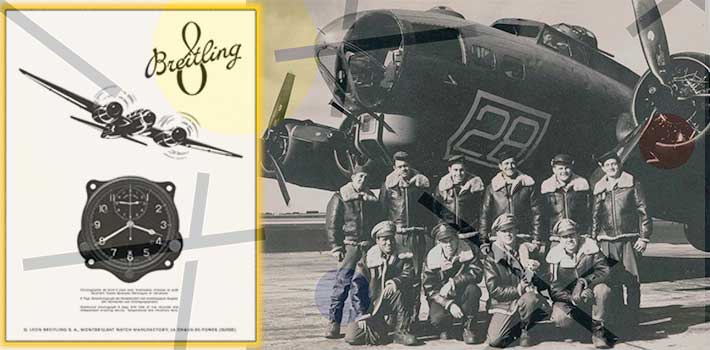
All these elements lead to the design, in 1934, of the addition of a second pusher and the development of the 170 chronograph just before the Second World War.
Breitling will be keen to respond to large orders from countries preparing to go to war, and will once again go above and beyond to produce this two-counter chronograph, powered by the robust Venus 170 movement, shockproof and capable of withstanding significant accelerations.
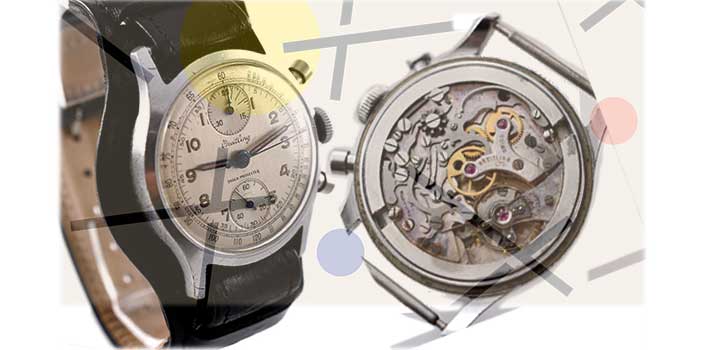
Widely distributed in equipment after the middle of the war, this military watch will accompany in their many missions: the pilots of the Royal Air Force and many others. She is recognized for being the one who gave the brand its letters of nobility and who served as the starting point for the design of the Navitimer and the specifications of the type 20 chronos for fighter pilots in the 1950s.
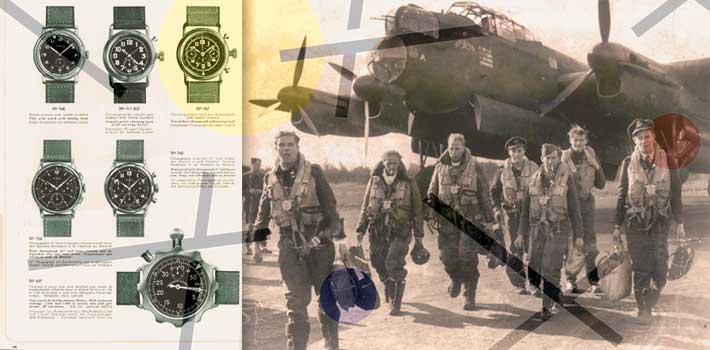
The Angels have wings to save us, the Navitimer watch too.
Ironically, these years also saw an increase in accidents due to problems encountered in flight, such as the landing crash of the Air France Lockheed Constellation in which Marcel Cerdan was on October 28, 1949, in the Azores, an accident due to a navigational error that was to have a lasting impact on world opinion and inspired Edith Piaf to write her famous Hymne à l'amour.
Because at the dawn of the 1950s, travel took on a new dimension, many qualified pilots were available following the war and progress made it possible to make planes that went further, faster and higher. With the use of the jet plane, the rise of airlines and the proliferation of travel. In the cockpit, three people: two pilots and a mechanic. All three need a chronograph capable of measuring time and a slide rule to convert and verify a multitude of variables such as: distance, speed, fuel consumption, drift due to "jet -streams” and flight time.
A challenge that Breitling immediately took up to create in 1952 what would become inseparable from the uniform of the new kings of the skies of the 1950s and 1960s: The Navitimer watch
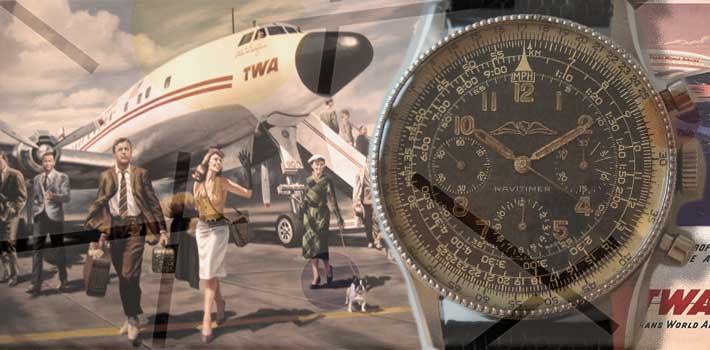
The Navitimer unites those who love each other...
Caliber Venus 178 will be one of the components that will allow Breitling to solve the equation:
Exact flight time + fair and controlled flight parameters = Safety.
A chronograph on which the pilot visualizes hours, minutes and seconds in the central position accompanied by a reminder on three mini counters in order to total the flight time:
Result: the pilot easily controls the time during his approach procedure and refers to his watch and his graduations to establish his changes of course or his reports. Because the navitimer chronograph facilitates all procedures: take-off, landing, frequency of messages with air traffic controllers when entering or exiting zones, the ease of use it provides makes it a real tool available to the air.
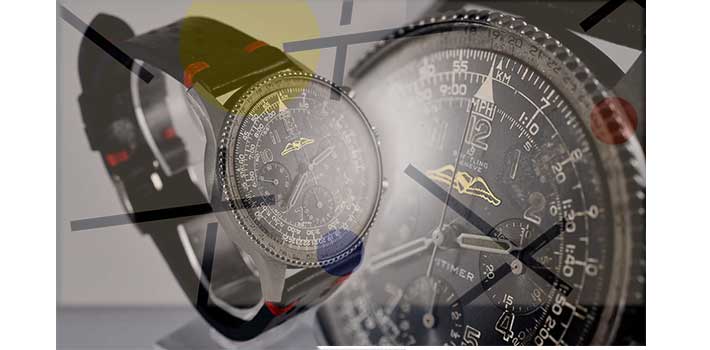
It will also be recommended by the AOPA (American Association of Pilots and Owners of Aircraft) and will become extremely popular in cockpits.
A take-off in sales resembling the first watch overbooking in history...
Impact of this success: the available stocks of the Vénus 178 movement would prove to be insufficient and it would be necessary to endure a wait of several months in order to obtain the precious slot which will allow this new sesame with golden wings to be received, a painful situation for both Breitling and for its potential customers.
In 1954 to face this shortage, Breitling decided to use a Valjoux 72 movement, (as in the no less famous Cosmograph Rolex Daytona) to satisfy the ever-increasing demand, this series very popular with aficionados will prove to be one of the best-selling watchmakers of the mid-1950s and remains, due to its limited production, one of the major acquisition objectives of any collector.
Faithful to its origins and strong in the notoriety of the Navitimer, in the following years Breitling continued to establish itself as the official supplier of world aviation and it was not uncommon since that time to find in the cockpits of Boeing 707 or others, a watch, on-board instrument, signed by the brand.
Notoriety such as it will be carried by many military pilots, such as the famous aviator and test pilot of the Marine Corps, Scott Carpenter, also known to have been selected by NASA in the orbital space flight program Mercury .

On May 24, 1962, with his Breitling Navitimer on his wrist above his flight suit, the astronaut took off to complete an orbital flight of 4 hours and fifty-two minutes at the controls of the Aurora 7 capsule of the Mercury 7 mission. .
A "cosmonaut" version will now follow, marketed in parallel with its aviation version, a marketing variant still in force, and available today and which differs from the latter by an hour dial calibrated in 24 hours to have the time of reference in exact day/night phase during loss of these references due to orbital flight.
The end of the 1960s, which saw the Omega Speedmaster Chronograph accompany Neil Armstrong to the Moon with the NASA Apollo program, signaled the beginning of the quest for performance by the entire watchmaking ecosystem, a quest that would reward the world market in the 1960s- ten numerous automatic or complicated models.
Breitling decided to change the mythical Venus 178 movement that powered its Navitimer and in anticipation to upgrade its model by equipping it with the Valjoux 7740 movement which offers the benefit of the date indication. The reaction of the aviation world is not long in coming, it is still a success and this watch which is approaching its twentieth anniversary is still fiercely worn by those who spend most of their time in the sky. A single highlight, in halftone, the famous AOPA logo will no longer adorn the dials of its models for a long time (it should be noted that at this time the Glycine Airman imposed itself as the rising star of the Air community, with its notoriety among American fighter pilots)
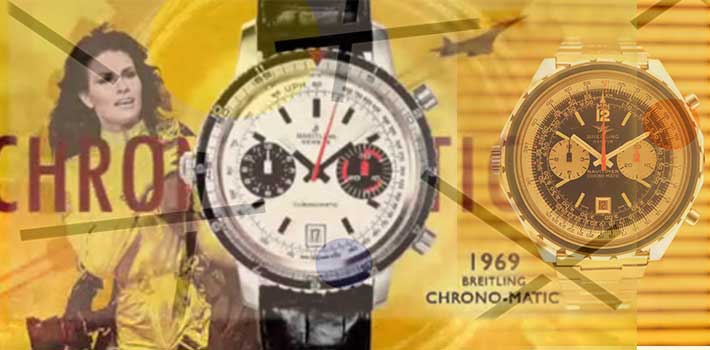
And in 1969, when man set foot on the moon for the first time, at the beginning of the period which saw the birth of Space Art, and to counter certainly the growing success of esteem which accompanies Omega's Speedmaster or the Astronaut model from Bullova since they accompanied NASA cosmonauts in the Apollo program into space, Breitling is revamping its range by opening up to 1970s design and Quartz technology....
With the disappearance of the line of the founders, a dark period will open for Breitling whose rest of the story (which you will find by following this link) will be synonymous with dismemberment towards the end of the 70s...
Later in the 1980s and 1990s, under the impetus of Ernest Schneider, the former soldier and aviation enthusiast, the industrialist already at the helm of the SICURA watch brand, restored Breitling's wings and brought the brand back to forefront of the watch industry.
